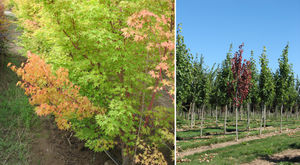Verticillium Wilt: Difference between revisions
Created page with "thumb|right|Japanese Maple (Right) and Red Maple (Left) with premature fall coloring due to Verticillium Wilt. =Introduction= Verticillium w..." |
No edit summary |
||
| Line 1: | Line 1: | ||
[[file: Vertfigure4composite.jpg|thumb|right|Japanese Maple (Right) and Red Maple (Left) with premature fall coloring due to Verticillium Wilt.]] | [[file: Vertfigure4composite.jpg|thumb|right|Japanese Maple (Right) and Red Maple (Left) with premature fall coloring due to Verticillium Wilt.]] | ||
=Introduction= | =Introduction= | ||
Verticillium wilt is the result of a soil-borne fungal pathogen called ''Verticillium dahliae'' that infects over 200 species of plants. In all there are ten recognized species of ''Verticillium'' but ''V. dahliae'' has the widest range of hosts. These can include, maple trees, tomato plants, eggplants, peach trees, black raspberry, spinach, pumpkin, alfalfa, hops, cherry trees, peony, snapdragons, chrysanthemums, etc. As said there are over 200 species that acts as a host, many of which include many important agriculture crops, or forest species. | Verticillium wilt is the result of a soil-borne fungal pathogen called ''Verticillium dahliae'' that infects over 200 species of plants[1]. In all there are ten recognized species of ''Verticillium'' but ''V. dahliae'' has the widest range of hosts. These can include, maple trees, tomato plants, eggplants, peach trees, black raspberry, spinach, pumpkin, alfalfa, hops, cherry trees, peony, snapdragons, chrysanthemums, etc[1]. As said there are over 200 species that acts as a host, many of which include many important agriculture crops, or forest species. | ||
=Characteristics= | =Characteristics= | ||
[[file:.JPG|left|thumb|200px|frame|caption.]] | [[file:.JPG|left|thumb|200px|frame|caption.]] | ||
= | =Signs and Symptoms= | ||
There are many signs and symptoms of Verticillium Wilt that a host plant may exhibit. These include, wilting of the leaves, chlorosis (yellowing of the leaves), stunted plant growth[1], the edges of the leaves my appear "scorched" or brown, and dead twigs and branches may appear. Specifically on maples areas of dead bark, called cankers, may appear[2]. [[file:maplecanker.JPG|left|thumb|200px|caption.]] | |||
These symptoms may appear on one side of the plant as a whole, one branch, or one grouping of leaves. Symptoms are most nocticble from mid to late summer or during times of extreme heat or drought[1]. | |||
[ | Symptoms expressed are dependent on the host for example, in spinach or cauliflower symptoms don't appear until the plant begins to flower[1]. | ||
[[file:crosssectionalvwilt.JPG|left|thumb|200px|frame|caption.]] | |||
[[file:longsectionalvwilt.JPG|left|thumb|200px|frame|caption.]] | |||
=Taxonomy= | =Taxonomy= | ||
| Line 20: | Line 27: | ||
=References= | =References= | ||
[1]Dung, Jeremiah K.S., and Jerry Weiland. “Verticillium Wilt in the Pacific Northwest.” Pacific Northwest Pest Management Handbooks, OSU | |||
Extension Service - Extension and Experiment Station Communications, 13 Oct. 2016, pnwhandbooks.org/plantdisease/pathogen- | |||
articles/common/fungi/verticillium-wilt-pacific-northwest. | |||
Anita. “Silver Maple - Bleeding Canker? - Ask an Expert.” EXtension, 14 June 2017, ask.extension.org/questions/406833. | |||
Brazee, Nicholas. “Verticillium Wilt.” Center for Agriculture, Food and the Environment, 26 Feb. 2018, ag.umass.edu/landscape/fact- | |||
sheets/verticillium-wilt. | |||
“Verticillium Wilt.” Verticillium Wilt | The Morton Arboretum, www.mortonarb.org/trees-plants/tree-and-plant-advice/help- | |||
diseases/verticillium-wilt. | |||
Revision as of 11:48, 2 May 2019

Introduction
Verticillium wilt is the result of a soil-borne fungal pathogen called Verticillium dahliae that infects over 200 species of plants[1]. In all there are ten recognized species of Verticillium but V. dahliae has the widest range of hosts. These can include, maple trees, tomato plants, eggplants, peach trees, black raspberry, spinach, pumpkin, alfalfa, hops, cherry trees, peony, snapdragons, chrysanthemums, etc[1]. As said there are over 200 species that acts as a host, many of which include many important agriculture crops, or forest species.
Characteristics
Signs and Symptoms
There are many signs and symptoms of Verticillium Wilt that a host plant may exhibit. These include, wilting of the leaves, chlorosis (yellowing of the leaves), stunted plant growth[1], the edges of the leaves my appear "scorched" or brown, and dead twigs and branches may appear. Specifically on maples areas of dead bark, called cankers, may appear[2].
These symptoms may appear on one side of the plant as a whole, one branch, or one grouping of leaves. Symptoms are most nocticble from mid to late summer or during times of extreme heat or drought[1].
Symptoms expressed are dependent on the host for example, in spinach or cauliflower symptoms don't appear until the plant begins to flower[1].
Taxonomy
Uses
References
[1]Dung, Jeremiah K.S., and Jerry Weiland. “Verticillium Wilt in the Pacific Northwest.” Pacific Northwest Pest Management Handbooks, OSU
Extension Service - Extension and Experiment Station Communications, 13 Oct. 2016, pnwhandbooks.org/plantdisease/pathogen-
articles/common/fungi/verticillium-wilt-pacific-northwest.
Anita. “Silver Maple - Bleeding Canker? - Ask an Expert.” EXtension, 14 June 2017, ask.extension.org/questions/406833.
Brazee, Nicholas. “Verticillium Wilt.” Center for Agriculture, Food and the Environment, 26 Feb. 2018, ag.umass.edu/landscape/fact-
sheets/verticillium-wilt.
“Verticillium Wilt.” Verticillium Wilt | The Morton Arboretum, www.mortonarb.org/trees-plants/tree-and-plant-advice/help-
diseases/verticillium-wilt.